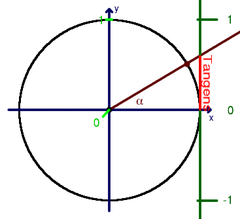De tangens en cotangens zijn goniometrische functies , aangeduid met tan {\displaystyle \tan } cot {\displaystyle \cot } t g {\displaystyle \mathrm {tg} } c o t g {\displaystyle \mathrm {cotg} } raaklijn in het Latijn , tangens betekent rakend. Het argument van de tangens en de cotangens wordt vaak gezien als een hoek en dat heeft te maken met de oorspronkelijke definitie van deze functies. De tangens was gedefinieerd als de verhouding van de overstaande en de aanliggende rechthoekszijde in een rechthoekige driehoek . Deze oorspronkelijke definitie beperkte echter het domein van het argument van 0° tot 90°. Tot 90°, omdat de tangens voor 90° niet is gedefinieerd.
De inverse functie van de tangens is de arctangens of boogtangens, die voor een gegeven waarde van de tangens als functiewaarde de oorspronkelijke hoek, tussen −90° en +90°, geeft.
De functiewaarde van de tangens loopt van 0 {\displaystyle 0} ∞ {\displaystyle \infty } − ∞ {\displaystyle -\infty } 0 {\displaystyle 0}
tan ( − α ) = − tan α {\displaystyle \tan(-\alpha )=-\tan \alpha } Beide functies kunnen in de sinus en cosinus worden uitgedrukt:
tan α = sin α cos α {\displaystyle \tan \alpha ={\frac {\sin \alpha }{\cos \alpha }}} cot α = cos α sin α {\displaystyle \cot \alpha ={\frac {\cos \alpha }{\sin \alpha }}} De cotangens van een hoek is dus de omgekeerde van de tangens van die hoek, mits cos α ≠ 0 {\displaystyle \cos \alpha \neq 0} sin α ≠ 0 {\displaystyle \sin \alpha \neq 0}
cot α = 1 tan α {\displaystyle \cot \alpha ={\frac {1}{\tan \alpha }}} graden 0° 30° 45° 60° 90° 120° 135° 150° 180° 270° radialen 0 {\displaystyle 0\ } 1 6 π {\displaystyle {\tfrac {1}{6}}\pi } 1 4 π {\displaystyle {\tfrac {1}{4}}\pi } 1 3 π {\displaystyle {\tfrac {1}{3}}\pi } 1 2 π {\displaystyle {\tfrac {1}{2}}\pi } 2 3 π {\displaystyle {\tfrac {2}{3}}\pi } 3 4 π {\displaystyle {\tfrac {3}{4}}\pi } 5 6 π {\displaystyle {\tfrac {5}{6}}\pi } π {\displaystyle \pi \ } 3 2 π {\displaystyle {\tfrac {3}{2}}\pi } tangens 0 {\displaystyle 0\ } 1 3 3 {\displaystyle {\tfrac {1}{3}}{\sqrt {3}}} 1 {\displaystyle 1\ } 3 {\displaystyle {\sqrt {3}}} geen − 3 {\displaystyle -{\sqrt {3}}} − 1 {\displaystyle -1\ } − 1 3 3 {\displaystyle -{\tfrac {1}{3}}{\sqrt {3}}} 0 {\displaystyle 0\ } geen cotangens geen 3 {\displaystyle {\sqrt {3}}} 1 {\displaystyle 1\,} 1 3 3 {\displaystyle {\tfrac {1}{3}}{\sqrt {3}}} 0 {\displaystyle 0\,} − 1 3 3 {\displaystyle -{\tfrac {1}{3}}{\sqrt {3}}} − 1 {\displaystyle -1\ } − 3 {\displaystyle -{\sqrt {3}}} geen 0 {\displaystyle 0\ }
De tangens en cotangens kunnen ook in de vorm van een machtreeks geschreven worden, bijvoorbeeld als taylorreeks . Voor | x | < π 2 {\displaystyle |x|<{\tfrac {\pi }{2}}}
tan x = x + 1 3 x 3 + 2 15 x 5 + 17 315 x 7 + … = ∑ n = 1 ∞ | B 2 n | 2 2 n ( 2 2 n − 1 ) ( 2 n ) ! x 2 n − 1 {\displaystyle \tan x=x+{\tfrac {1}{3}}x^{3}+{\tfrac {2}{15}}x^{5}+{\tfrac {17}{315}}x^{7}+\ldots =\sum _{n=1}^{\infty }|B_{2n}|{\frac {2^{2n}\left(2^{2n}-1\right)}{(2n)!}}x^{2n-1}} cot x = x − 1 − 1 3 x − 1 45 x 3 − 2 945 x 5 − … = ∑ n = 0 ∞ ( − 1 ) n B 2 n 2 2 n ( 2 n ) ! x 2 n − 1 {\displaystyle \cot x=x^{-1}-{\tfrac {1}{3}}x-{\tfrac {1}{45}}x^{3}-{\tfrac {2}{945}}x^{5}-\ldots =\sum _{n=0}^{\infty }(-1)^{n}B_{2n}{\frac {2^{2n}}{(2n)!}}x^{2n-1}} Daarin is B n {\displaystyle B_{n}} n {\displaystyle n} bernoulligetal .
Beschouwt men x {\displaystyle x} x {\displaystyle x} radialen .
Driehoek In een driehoek △ A B C {\displaystyle \triangle ABC} rechte hoek geldt voor de grootte van de hoeken:
tan α + tan β + tan γ = tan α ⋅ tan β ⋅ tan γ {\displaystyle \tan \alpha +\tan \beta +\tan \gamma =\tan \alpha \cdot \tan \beta \cdot \tan \gamma } cot α 2 + cot β 2 + cot γ 2 = cot α 2 ⋅ cot β 2 ⋅ cot γ 2 {\displaystyle \cot {\frac {\alpha }{2}}+\cot {\frac {\beta }{2}}+\cot {\frac {\gamma }{2}}=\cot {\frac {\alpha }{2}}\cdot \cot {\frac {\beta }{2}}\cdot \cot {\frac {\gamma }{2}}} De tangensregel geldt voor alle driehoeken en geeft het volgende verband:
a − b a + b = tan 1 2 ( α − β ) tan 1 2 ( α + β ) {\displaystyle {\frac {a-b}{a+b}}={\frac {\tan {\tfrac {1}{2}}(\alpha -\beta )}{\tan {\tfrac {1}{2}}(\alpha +\beta )}}} 


 French
French Deutsch
Deutsch









































